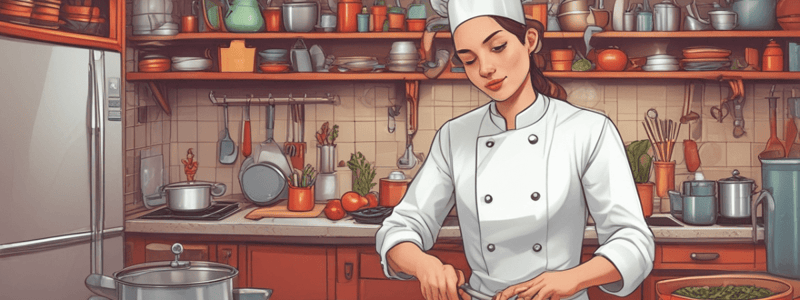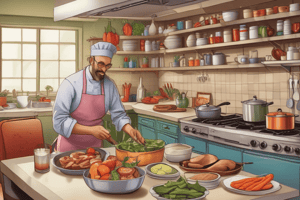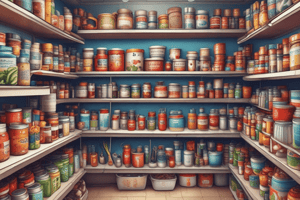Podcast
Questions and Answers
What is the French term that means 'everything put in place' in kitchen lingo?
What is the French term that means 'everything put in place' in kitchen lingo?
- Kitchen prep
- Food preparation
- Culinary setup
- Mise en place (correct)
A dish's quality improves as it is held.
A dish's quality improves as it is held.
False (B)
What is the first step in pre-preparation according to the text?
What is the first step in pre-preparation according to the text?
Assembling and preparing the components
The core of kitchen organizing is dealing with _______________________.
The core of kitchen organizing is dealing with _______________________.
Match the steps in pre-preparation with their descriptions:
Match the steps in pre-preparation with their descriptions:
Why is preparation necessary in a kitchen?
Why is preparation necessary in a kitchen?
Final cooking should take place as close to service as possible.
Final cooking should take place as close to service as possible.
What are the two inevitable facts that every food-service organization must contend with?
What are the two inevitable facts that every food-service organization must contend with?
What is the primary function of the sachet in the brine recipe?
What is the primary function of the sachet in the brine recipe?
The brine recipe yields a 6% salt concentration.
The brine recipe yields a 6% salt concentration.
What is the purpose of breading in deep-fried foods?
What is the purpose of breading in deep-fried foods?
Before deep-frying, pan-frying, or sautéing, some ingredients are coated with ______________________.
Before deep-frying, pan-frying, or sautéing, some ingredients are coated with ______________________.
Match the following ingredients with their corresponding quantities in the brine recipe:
Match the following ingredients with their corresponding quantities in the brine recipe:
Why might pan drippings not be suitable for deglazing?
Why might pan drippings not be suitable for deglazing?
The sugar in the brine recipe can burn to the bottom of the roasting pan.
The sugar in the brine recipe can burn to the bottom of the roasting pan.
What is the recommended marinating time for large cuts of meat in the brine recipe?
What is the recommended marinating time for large cuts of meat in the brine recipe?
What is the primary purpose of precooking and seasoning ingredients before using them in a finished recipe?
What is the primary purpose of precooking and seasoning ingredients before using them in a finished recipe?
Blanching is a dry-heat cooking method.
Blanching is a dry-heat cooking method.
What are the four main reasons for blanching or par cooking?
What are the four main reasons for blanching or par cooking?
Par cooking is used to loosen the skins of _______________________ and fruits such as tomatoes and peaches.
Par cooking is used to loosen the skins of _______________________ and fruits such as tomatoes and peaches.
What is the purpose of marinade?
What is the purpose of marinade?
Blanching is a slow cooking process.
Blanching is a slow cooking process.
Match the following cooking methods with their characteristics:
Match the following cooking methods with their characteristics:
What is the benefit of precooking ingredients such as roast duck?
What is the benefit of precooking ingredients such as roast duck?
What is the primary goal of pre-preparation in meal preparation?
What is the primary goal of pre-preparation in meal preparation?
All ingredients should be prepared and held at room temperature.
All ingredients should be prepared and held at room temperature.
What is the ideal temperature for maintaining the quality of perishable meats, seafood, and vegetables?
What is the ideal temperature for maintaining the quality of perishable meats, seafood, and vegetables?
A stock may take __________ to __________ hours to create.
A stock may take __________ to __________ hours to create.
What is a benefit of blanching and chilling green peas instead of preparing a full batch?
What is a benefit of blanching and chilling green peas instead of preparing a full batch?
Vegetables should be kept hot for extended periods of time to ensure food safety.
Vegetables should be kept hot for extended periods of time to ensure food safety.
Match the following equipment with their ideal usage:
Match the following equipment with their ideal usage:
What is the recommended temperature for holding sauces and soups?
What is the recommended temperature for holding sauces and soups?
What is a convenience food?
What is a convenience food?
Buying a convenience food always costs less than buying the raw materials.
Buying a convenience food always costs less than buying the raw materials.
What is one advantage of using convenience foods in a kitchen?
What is one advantage of using convenience foods in a kitchen?
The more completely a product is prepared by the manufacturer, the less it reflects the ____________________ of the food-service operator.
The more completely a product is prepared by the manufacturer, the less it reflects the ____________________ of the food-service operator.
Which of the following is an example of a partially prepared convenience food?
Which of the following is an example of a partially prepared convenience food?
A product prepared from scratch is always superior to one built from a convenience base.
A product prepared from scratch is always superior to one built from a convenience base.
Fresh product has the potential to be the best, but not if it is ____________________ stored or handled.
Fresh product has the potential to be the best, but not if it is ____________________ stored or handled.
Match the following convenience foods with their descriptions:
Match the following convenience foods with their descriptions:
Flashcards are hidden until you start studying
Study Notes
Kitchen Organization and Preparation
- Mise en place, a French term, refers to the process of preparing and organizing ingredients and tools before cooking to ensure a smooth and efficient cooking process.
- It involves planning, preparing, and holding ingredients and dishes to ensure quality and freshness.
Planning and Organizing Production
- Preparation is essential in both professional and home kitchens to ensure a dish's performance.
- The process involves gathering tools and ingredients, preparing raw materials, and setting up tools.
- In commercial kitchens, planning and organization are crucial to manage complexity and ensure quality.
The Problem and Solution
- The problem in kitchen organization is managing the complexity of preparing multiple dishes and ensuring quality and freshness.
- The solution is to carefully plan pre-preparation, which involves breaking down each menu item into production steps, pre-preparation, holding, and production planning.
Pre-Preparation
- Pre-preparation involves assembling and preparing components of a dish, such as cleaning and cutting vegetables, cutting and trimming meats, and preparing breadings and batters.
- It also involves deciding which processes can be completed ahead of time and how to hold items at the end of the pre-preparation process.
Holding and Production Planning
- Holding involves maintaining the quality of each item at the end of the pre-preparation process, using techniques such as steam tables, refrigeration, and proper temperature control.
- Production planning involves determining how long it will take to prepare each stage of each recipe and creating a production timeline.
Preliminary Cooking and Flavoring
- Advance preparation often involves precooking and seasoning ingredients before they can be used in the finished recipe.
- Precooking and seasoning can improve the holding quality of ingredients, conserve time, eliminate unpleasant flavors, and allow for further processing.
Blanching and Par Cooking
- Blanching and par cooking are used to partially cook ingredients to improve their holding quality, conserve time, eliminate unpleasant flavors, and allow for further processing.
- These techniques involve using moist-heat or dry-heat methods, such as simmering, boiling, steaming, or deep-frying.
Marinade
- Marinade is a seasoned liquid used to soak ingredients to add flavor, tenderize, and preserve.
- A basic marinade recipe involves combining water, salt, sugar, and herbs and spices, then bringing the mixture to a boil, cooling, and refrigerating.
Brine
- Brine is a marinade used to preserve and add flavor to meats and poultry.
- A brine recipe involves combining water, salt, sugar, and herbs and spices, then bringing the mixture to a boil, cooling, and refrigerating.
Preparation for Frying
- Most deep-fried meals are coated with a protective layer of breading or batter before frying.
- This coating aids in retaining moisture and flavor, protects the fat from moisture and salt, prevents excessive fat absorption, and improves crispness and appearance.
Breading and Convenience Foods
- Breading is used to coat ingredients before frying to improve their texture and flavor.
- Convenience foods are partially or fully prepared products that can be used in recipes, saving time and increasing kitchen efficiency.
- Examples of convenience foods include frozen fish fillets, peeled potatoes, concentrated stock bases, and frozen puff pastry dough.
Studying That Suits You
Use AI to generate personalized quizzes and flashcards to suit your learning preferences.




